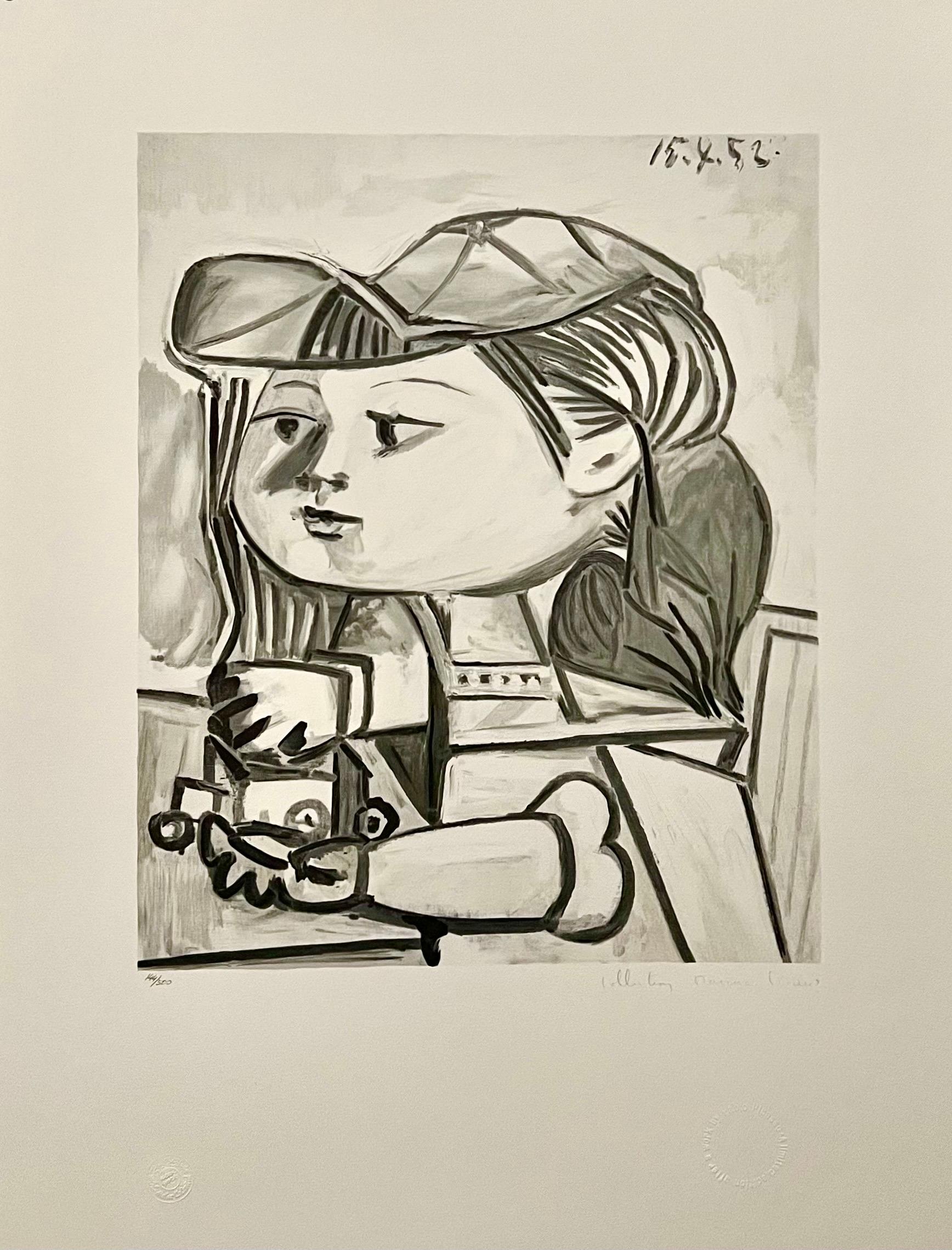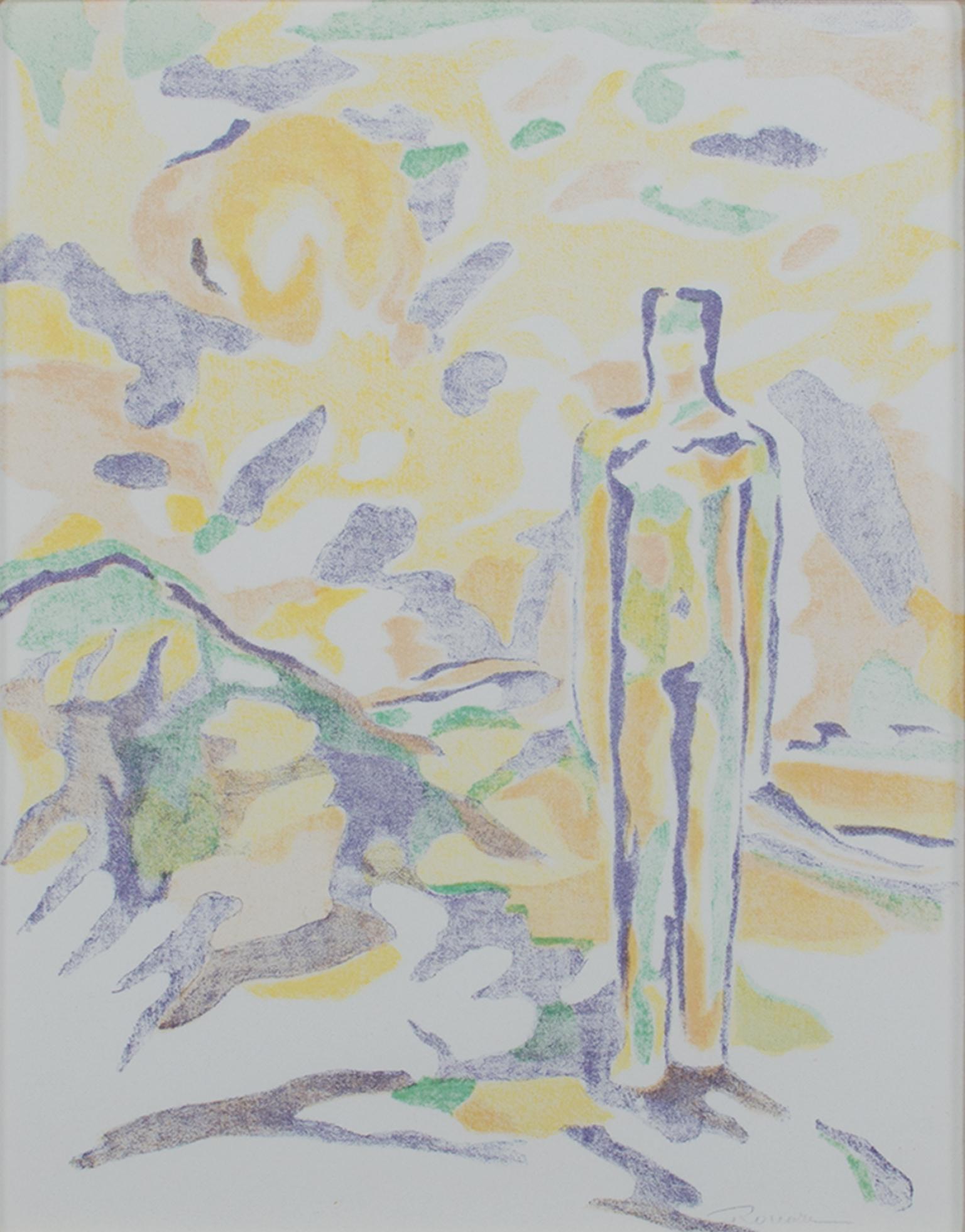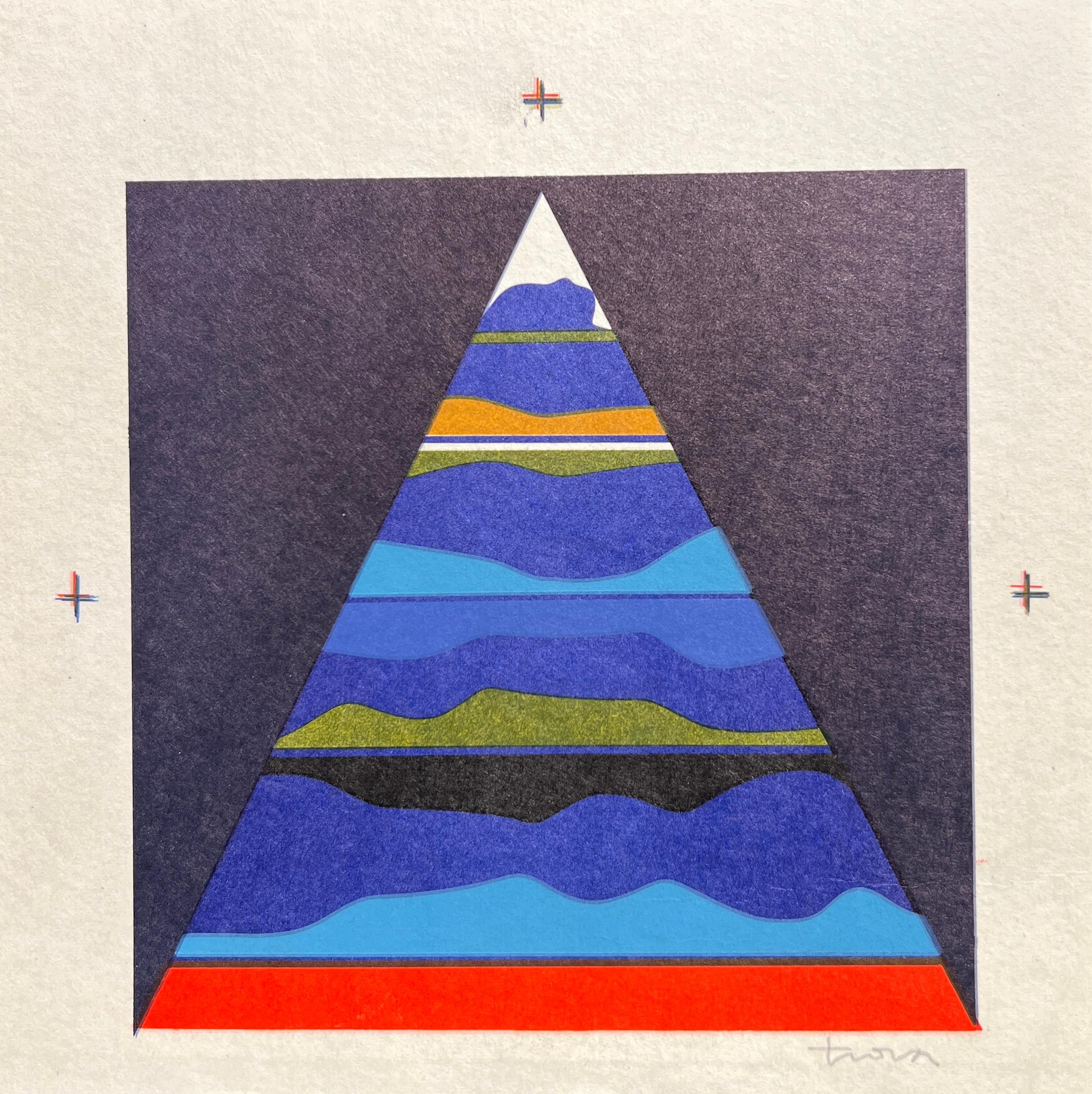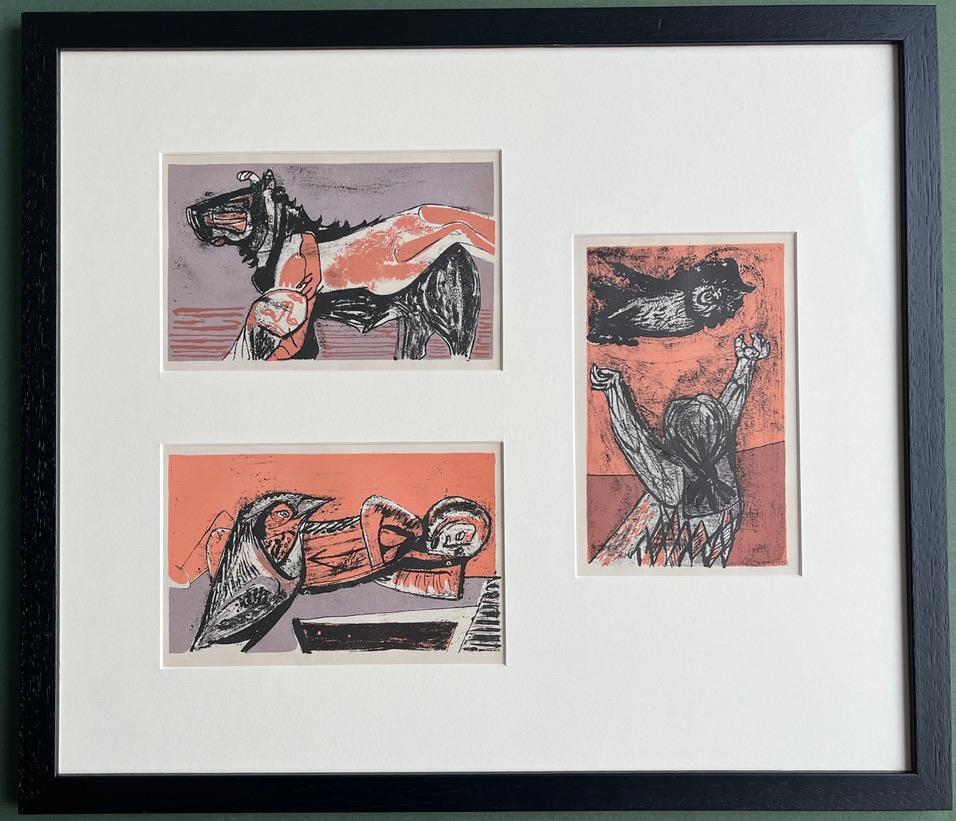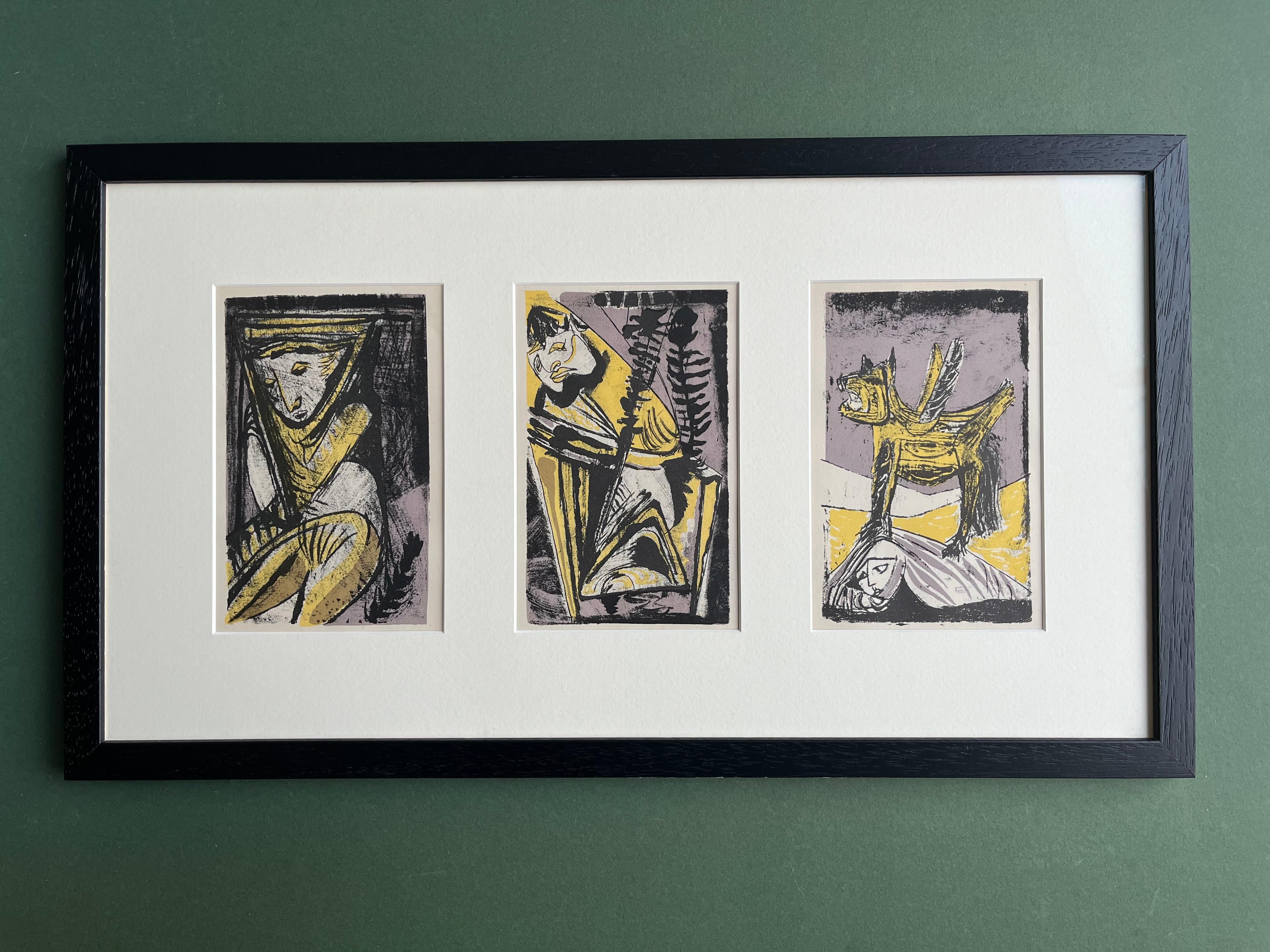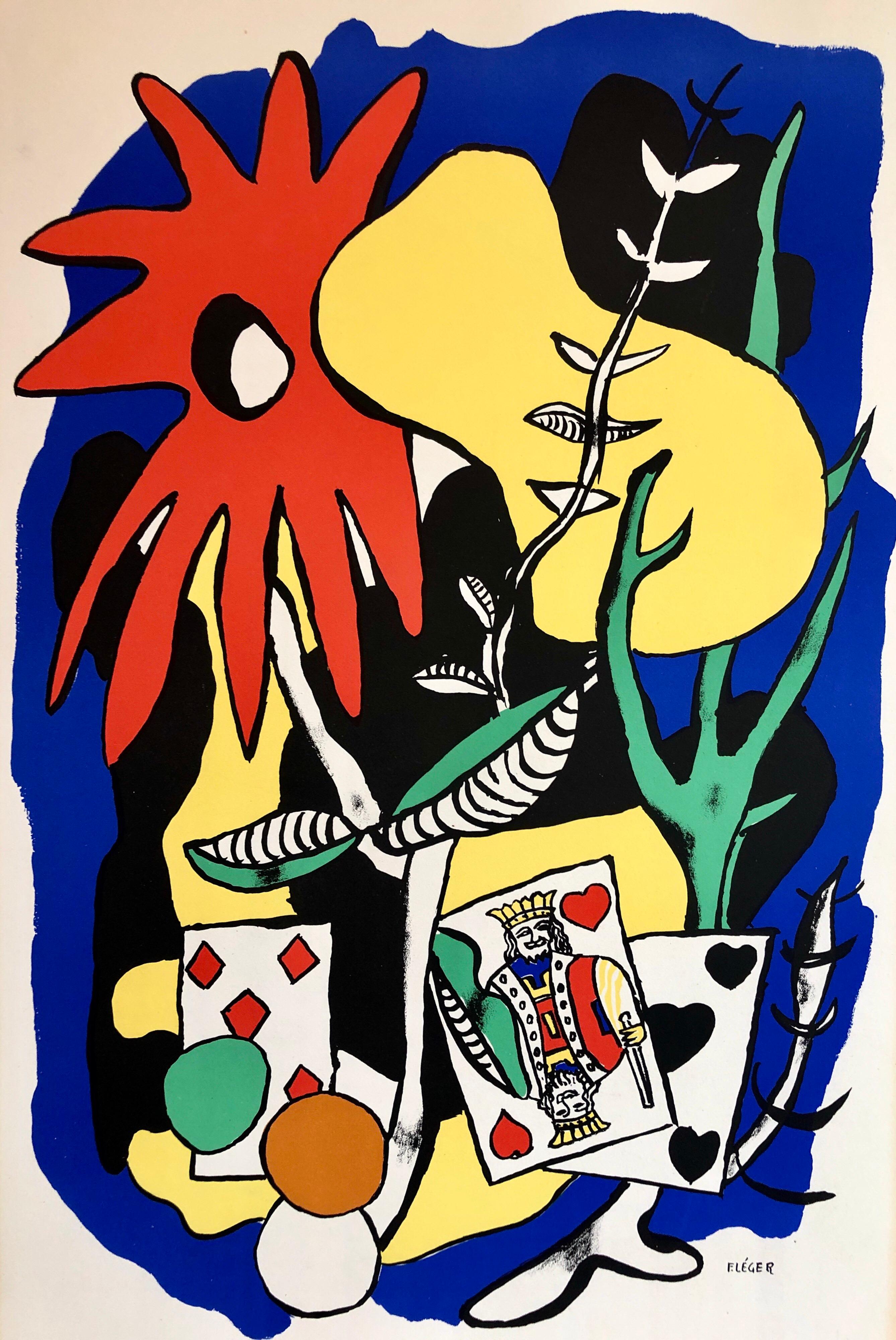Items Similar to Raoul Dufy School Prints Colorful Modernist Drawing Lithograph Marching Band
Want more images or videos?
Request additional images or videos from the seller
1 of 10
(after) Raoul DufyRaoul Dufy School Prints Colorful Modernist Drawing Lithograph Marching Bandc.1949
c.1949
About the Item
Bright vibrant blue, yellow lithograph in color. This is signed in the plate and dated. Dufy's abstract drawing lithograph was drawn by the artist direct on to plastic plates newly developed by Cowell's of Ipswich, and proofed under his supervision. The original edition called for 3000. I do not know how many were actually printed.
The sheer logistics of the operation, the costly effort of distribution to over 4000 schools, finally ended the great adventure of the School Prints scheme. The expensive endeavor peaked in 1949 with the magnificent European series, made possible by the plastic portable plates, which, in addition to Moore, featured Henri Matisse, Pablo Picasso, Fernand Leger, Raoul Dufy and Georges Braque.
Raoul Dufy (French 1877 – 1953) was a French Fauvist painter, brother of Jean Dufy. He developed a colorful, decorative style that became fashionable for designs of ceramics and textiles, as well as decorative schemes for public buildings. He is noted for scenes of open-air social events. He was also a draftsman, printmaker, book illustrator, scenic designer, a designer of furniture, and a planner of public spaces. In 1895, when he was 18, he started taking evening classes in art at Le Havre's École des Beaux-Arts (municipal art school). The classes were taught by Charles Lhuillier, who had been, forty years earlier, a student of the French portrait-painter, Ingres. There, Dufy met Raymond Lecourt and Othon Friesz with whom he later shared a studio in Montmartre and to whom he remained a lifelong friend. During this period, Dufy painted mostly Norman landscapes in watercolors. In 1900, after a year of military service, Dufy won a scholarship to the École nationale supérieure des Beaux-Arts in Paris, where again he crossed paths with Othon Friesz. (He was there when Georges Braque also was studying.) He concentrated on improving his drawing skills. The impressionist landscape painters, such as Claude Monet and Camille Pissarro, influenced Dufy profoundly. His first exhibition (at the Exhibition of French Artists) took place in 1901. Introduced to Berthe Weill in 1902, Dufy showed his work in her gallery. Then he exhibited again in 1903 at the Salon des Indépendants. A boost to his confidence: the painter, Maurice Denis, bought one of his paintings. Dufy continued to paint, often in the vicinity of Le Havre, and, in particular, on the beach at Sainte-Adresse, made famous by Eugène Boudin and Claude Monet. In 1904, with his friend, Albert Marquet, he worked in Fecamp on the English Channel (La Manche).
Henri Matisse's Luxe, Calme et Volupté, which Dufy saw at the Salon des Indépendants in 1905, was a revelation to the young artist, and it directed his interests towards Fauvism. Les Fauves (the wild beasts) emphasized bright color and bold contours in their work. Dufy's painting reflected this aesthetic until about 1909, when contact with the work of Paul Cézanne led him to adopt a somewhat subtler technique. It was not until 1920, however, after he had flirted briefly with yet another style, cubism, that Dufy developed his own distinctive approach. It involved skeletal structures, arranged with foreshortened perspective, and the use of thin washes of color applied quickly, in a manner that came to be known as stenographic. Dufy's cheerful oils and watercolors depict events of the time period, including yachting scenes, sparkling views of the French Riviera, chic parties, and musical events. The optimistic, fashionably decorative, and illustrative nature of much of his work has meant that his output has been less highly valued critically than the works of artists who have addressed a wider range of social concerns.
Dufy completed one of the largest paintings ever contemplated, a huge and immensely popular ode to electricity, the fresco La Fée Electricité for the 1937 Exposition Internationale in Paris.
Dufy also acquired a reputation as an illustrator and as a commercial artist. He painted murals for public buildings; he also produced a huge number of tapestries and ceramic designs. His plates appear in books by Guillaume Apollinaire, Stéphane Mallarmé, and André Gide.
In 1909, Raoul Dufy was commissioned by Paul Poiret to design stationery for the house, and after 1912 designed textile patterns for Bianchini-Ferier used in Poiret's and Charvet's garments.
In the late 1940s and early 1950s, Dufy exhibited at the annual Salon des Tuileries in Paris. In 1952 he received the grand prize for painting in the 26th Venice Biennale.
Among the public collections holding works by Raoul Dufy are:
Van Abbemuseum
Museum de Fundatie, Zwolle, Netherlands
McNay Art Museum
Art Gallery of Ontario
Musée d'Art Moderne de la Ville de Paris
Illustrations
Jean Cocteau, Bertrand Guégan (1892-1943); L'almanach de Cocagne pour l'an 1920-1922, Dédié aux vrais Gourmands Et aux Francs Buveurs
- Creator:(after) Raoul Dufy (French)
- Creation Year:c.1949
- Dimensions:Height: 25.25 in (64.14 cm)Width: 35.5 in (90.17 cm)
- Medium:
- Movement & Style:
- Period:
- Condition:the piece is mounted to another paper for support, as issued. minor wear. the lithograph is in good condition with minor age toning commensurate with age. please see photos.
- Gallery Location:Surfside, FL
- Reference Number:1stDibs: LU38214212512
About the Seller
4.9
Platinum Seller
These expertly vetted sellers are 1stDibs' most experienced sellers and are rated highest by our customers.
Established in 1995
1stDibs seller since 2014
1,559 sales on 1stDibs
Typical response time: 1 hour
- ShippingRetrieving quote...Ships From: Surfside, FL
- Return PolicyA return for this item may be initiated within 3 days of delivery.
More From This SellerView All
- Pablo Picasso Estate Hand Signed Cubist Lithograph Abstract Girl Portrait TeteBy (after) Pablo PicassoLocated in Surfside, FLPablo Picasso (after) "Buste de Petite Fille" limited edition print on Arches paper, Hand signed by Marina Picasso lower right and numbered 144/500 lower left From the estate of Pa...Category
20th Century Modern Abstract Prints
MaterialsLithograph
- Fernand Leger School Prints Colorful Modernist King of Hearts Drawing LithographBy (after) Fernand LégerLocated in Surfside, FLBright vibrant blue, orange, red, yellow, green lithograph in color. This is signed in the plate and dated. Leger's abstract drawing lithograph was drawn by the artist direct on to p...Category
1940s Modern Abstract Prints
MaterialsLithograph
- Large Venezuelan Modernist Lithograph "The Balcony #3" Color PrintBy Marius SznajdermanLocated in Surfside, FLMarius Sznajderman was a painter, printmaker and scenic designer living and working in the United States. Born in Paris, France in 1926 his Jewish parents had migrated to France from Poland in 1923. In November 1942 the family fled Nazi-occupied France for Spain before settling in Caracas, Venezuela. He attended the School of Fine Arts in Caracas where his teachers included illustrator Ramon Martin Durban, scenic designer Charles Ventrillon-Horber and painter Rafael Monasterios. and immigrated to the United States in 1949, where he received a Bachelor of Fine Arts and Master of Fine Arts from Columbia University in New York. He settled in Hackensack, New Jersey, where he lived and had a studio for more than 50 years before moving to Amherst, Massachusetts in 2015. His work, which includes painting, prints and collages, as well as set designs, is in more than 45 museum and public institution collections in the United States, Latin America and Israel. He held more than 40 solo exhibitions at galleries and museums and participated in more than 75 group shows around the globe. He helped found the Taller Libre de Arte, an experimental workshop for the visual arts, sponsored by the Ministry of Education. The Taller Libre de Arte was a center for young artists to work and to meet with critics and intellectuals to discuss avant-garde ideas and artistic trends from Europe and Latin America. Among the notable artists who participated in the Taller Libre de Arte were Ramón Vásquez Brito, Carlos González Bogen, Luis Guevara Moreno, Mateo Manaure, Virgilio Trómpiz...Category
20th Century Modern Figurative Prints
MaterialsLithograph
- Pablo Picasso Estate Hand Signed Lithograph Engraving Fauvist Dove of PeaceBy (after) Pablo PicassoLocated in Surfside, FLPablo Picasso (after) "Etudes des Mains et Colombe" limited edition print on Arches paper, Hand signed by Marina Picasso lower right and numbered 482/500 lower left From the estate of Pablo Picasso with an embossed blindstamp in the lower right side of the piece. After Pablo Picasso's death in 1973, his granddaughter Marina authorized the printing of these original lithographs, which have come to be known as the Picasso Estate...Category
20th Century Modern Abstract Prints
MaterialsLithograph, Engraving
- Pablo Picasso Estate Hand Signed Cubist Lithograph Abstract Woman Portrait TeteBy (after) Pablo PicassoLocated in Surfside, FLPablo Picasso (after) "Femme Assise dans un Fauteuil" limited edition print on Arches paper, Hand signed by Marina Picasso lower right and numbered 284/500 lower left From the estat...Category
20th Century Modern Abstract Prints
MaterialsLithograph
- Henry Moore 1973 Lithograph edition 28/75 Sculpture Figures Reclining NudesBy Henry MooreLocated in Surfside, FLHenry Spencer Moore (1898 – 1986) Moore was born in Castleford, the son of a coal miner. He became well-known through his carved marble and larger-scale abstract cast bronze sculptures, and was instrumental in introducing a particular form of modernism to the United Kingdom later endowing the Henry Moore Foundation, which continues to support education and promotion of the arts. After the Great War, Moore received an ex-serviceman's grant to continue his education and in 1919 he became a student at the Leeds School of Art (now Leeds College of Art), which set up a sculpture studio especially for him. At the college, he met Barbara Hepworth, a fellow student who would also become a well-known British sculptor, and began a friendship and gentle professional rivalry that lasted for many years. In Leeds, Moore also had access to the modernist works in the collection of Sir Michael Sadler, the University Vice-Chancellor, which had a pronounced effect on his development. In 1921, Moore won a scholarship to study at the Royal College of Art in London, along with Hepworth and other Yorkshire contemporaries. While in London, Moore extended his knowledge of primitive art and sculpture, studying the ethnographic collections at the Victoria and Albert Museum and the British Museum. Moore's familiarity with primitivism and the influence of sculptors such as Constantin Brâncuși, Jacob Epstein, Henri Gaudier-Brzeska and Frank Dobson led him to the method of direct carving, in which imperfections in the material and marks left by tools became part of the finished sculpture. After Moore married, the couple moved to a studio in Hampstead at 11a Parkhill Road NW3, joining a small colony of avant-garde artists who were taking root there. Shortly afterward, Hepworth and her second husband Ben Nicholson moved into a studio around the corner from Moore, while Naum Gabo, Roland Penrose, Cecil Stephenson and the art critic Herbert Read also lived in the area (Read referred to the area as "a nest of gentle artists"). This led to a rapid cross-fertilization of ideas that Read would publicise, helping to raise Moore's public profile. The area was also a stopping-off point for many refugee artists, architects and designers from continental Europe en route to America—some of whom would later commission works from Moore. In 1932, after six year's teaching at the Royal College, Moore took up a post as the Head of the Department of Sculpture at the Chelsea School of Art. Artistically, Moore, Hepworth and other members of The Seven and Five Society would develop steadily more abstract work, partly influenced by their frequent trips to Paris and their contact with leading progressive artists, notably Pablo Picasso, Georges Braque, Jean Arp and Alberto Giacometti. Moore flirted with Surrealism, joining Paul Nash's modern art movement "Unit One", in 1933. In 1934, Moore visited Spain; he visited the cave of Altamira (which he described as the "Royal Academy of Cave Painting"), Madrid, Toledo and Pamplona. Moore made his first visit to America when a retrospective exhibition of his work opened at the Museum of Modern Art in New York City.[28] Before the war, Moore had been approached by educator Henry Morris, who was trying to reform education with his concept of the Village College. Morris had engaged Walter Gropius as the architect for his second village college at Impington near Cambridge, and he wanted Moore to design a major public sculpture for the site. In the 1950s, Moore began to receive increasingly significant commissions. He exhibited Reclining Figure: Festival at the Festival of Britain in 1951, and in 1958 produced a large marble reclining figure for the UNESCO building in Paris. With many more public works of art, the scale of Moore's sculptures grew significantly and he started to employ an increasing number of assistants to work with him at Much Hadham, including Anthony Caro and Richard Wentworth. Moore produced at least three significant examples of architectural sculpture during his career. In 1928, despite his own self-described extreme reservations, he accepted his first public commission for West Wind for the London Underground Building at 55 Broadway in London, joining the company of Jacob Epstein and Eric Gill..At an introductory speech in New York City for an exhibition of one of the finest modernist sculptors, Alberto Giacometti, Sartre spoke of The beginning and the end of history...Category
1970s Modern Abstract Prints
MaterialsLithograph
You May Also Like
- Pour Daniel-Henry Kahnweiler Figure in LandscapeBy Yves RouvreLocated in Milwaukee, WI"Pour Daniel-Henry Kahnweiler Figure in Landscape" is an original lithograph by Yves Rouvre. The artist signed the piece lower right. It features an abstracted figure in fields of co...Category
1960s Modern Figurative Prints
MaterialsLithograph
- Study/Falling Man (Series II)By Ernest Tino TrovaLocated in Missouri, MOStudy/Falling Man (Series II), 1967 By. Ernest Tino Trova (American, 1927-2009) Signed in Pencil Lower Right Color Lithograph Unframed: 6 x 6 inches With Frame: 8.75 x 8.5 inches Kn...Category
20th Century American Modern Abstract Prints
MaterialsLithograph
- Modern British art, Scottish Modernist printLocated in Harkstead, GBThese wonderful lithographs from the imagination of the Glasgow artist Robert Colquhoun are full of colour and dynamism. Robert Colquhoun (1914-1962) Poems of Sleep and dream Three ...Category
Mid-20th Century Modern Abstract Prints
MaterialsPaper, Lithograph
- Modern British art, Scottish Modernist printLocated in Harkstead, GBThese wonderful lithographs from the imagination of the Glasgow artist Robert Colquhoun are full of colour and dynamism. Robert Colquhoun (1914-1962) Poems of Sleep and dream Three ...Category
Mid-20th Century Modern Abstract Prints
MaterialsPaper, Lithograph
- Blues, important signed/N lithograph by renowned African American artist FramedBy Elizabeth CatlettLocated in New York, NYElizabeth Catlett Blues, 1983 Color lithograph on cream wove paper Signed, titled, dated and numbered in graphite pencil on the front Printed and published by the Brandywine Workshop...Category
1980s Modern Figurative Prints
MaterialsLithograph, Pencil
- My Love We Wont - coveted, whimsical 1960s silkscreen by beloved female artistBy Niki de Saint PhalleLocated in New York, NYNiki de Saint Phalle My Love We Wont, 1968 Lithograph and silkscreen on wove paper Signed and numbered 51/75 in graphite pencil on the front Frame included: elegantly floated and framed in a museum quality white wood frame with UV plexiglass From the Brooklyn Museum, which has an edition of this work in its permanent collection: "Throughout her long and prolific career Niki de Saint Phalle, a former cover model for Life magazine and French Vogue, investigated feminine archetypes and women’s societal roles. Her Nanas, bold, sexy sculptures...Category
1960s Modern Abstract Prints
MaterialsScreen, Mixed Media, Lithograph, Pencil
